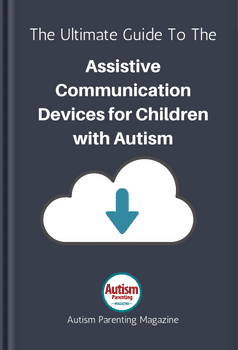Assistive technology includes devices, software, or equipment that help individuals with disabilities complete tasks they might struggle with. For students with autism, it promotes independence, enhances communication, and improves daily functioning. These tools can make information more accessible, help students express their thoughts, and support participation in classroom discussions and social interactions.
Assistive technology enhances students’ academic and social skills by enabling them to communicate, move independently, and engage in learning. For parents and educators, understanding the impact of these tools can make a significant difference in helping students with autism thrive in school and beyond.

Download your FREE guide on
Assistive Communication Devices for Children with Autism
Types of assistive technology for students with autism: Low-tech vs. high-tech
Assistive technology can be used in both the home and classroom settings. There are many different factors to consider when looking for assistive technology for your student. The best type for each individual will depend on their needs and preferences.
What would work best for your student depends on their needs. Each student is unique, so what works great for one may not help the other.
There are many different types of assistive technology, but they can be divided into two categories: high-tech and low-tech.
High-tech assistive technology for autism in the classroom
High-tech assistive technology includes electronic and computer-based tools designed to help with independence, accessibility, and quality of life.
It tends to be more versatile and can offer advanced features, integration with other devices, and customization possibilities. However, these devices are also more complex and may require training.
They come with a higher price tag and need someone who understands the technical aspects.

High-tech assistive technology includes a variety of items. Here are some high-tech assistive technology examples:
- Speech-generating devices help nonverbal students communicate with others. They are electronic devices that can be held or used on tablets or laptops. Students use them to select words, phrases, or sentences. They can also be used to type messages that are then spoken aloud through the device.
- Interactive whiteboards can help students participate in classroom activities. They have a large touchscreen display that students can use to interact with the lessons. They also integrate various learning styles, like sight, sound, and touch.
- Screen reader devices are helpful for websites. They will allow users to have the digital content read aloud. This is typically used with headphones in a classroom.
- Eye gaze technology is a developing technology that tracks eye movements on a grid pad to help communication. A student will look at the word or picture they want to communicate.
- Power wheelchairs can be operated by students with limited mobility.
- Robots can help students with social skills. They mimic human interaction and reaction to various social skills situations.
Low-tech assistive technology for autism in the classroom
Low-tech assistive technology is simpler, widely available, and has a lower price tag. It can be less versatile and have limited customization. They are typically easy to use and need minimal training but may need to be replaced often.
Low-tech assistive technology also has many options. Here are a few examples:
- A picture exchange communication system (PECS) board uses pictures, symbols, words, or photographs to help nonverbal students communicate their wants and needs. These could be customized into choice boards, visual schedules, or anything else that would benefit your student.
- Visual timers help students track time. They can tell them how much time remains in class or for a test or assignment.
- Talking calculators speak the numbers and can help students with visual or processing issues with mathematical equations.
- Social skills videos can help students navigate acceptable behavior in social situations, even if your student is nonverbal. They can see how others react to certain situations.
- Weighted blankets can provide sensory input, which can help with anxiety. Some students with autism like the feel of regulated, steady pressure, and this helps calm them.
- Noise-cancellation headphones can help a student drown out all the outside noise and activity, which can help with focus and anxiety. These are particularly helpful when the class has free time, and a student would like to read or do their homework.
- A sit-and-spin or other safe spinning device can help calm their vestibular system. You must ensure the device has a solid base so it will not fall over. Spinning should be started slowly to see if your student enjoys it. If their eyes flick left to right after the spin, this means they are dizzy, and spinning should not be continued.
- A regular wheelchair, walker, belt seat, knee walker, gait mobility system, or other mobility aid can help a student with mobility at home, in school, or in the outside environment.
How to apply assistive technology in an autism-friendly classroom
Assistive technology can be helpful, but it comes with its own set of challenges. Many devices and software can be expensive, which limits access for some families. For some of the more technical ones, training is needed for the student, parents, and teacher.
If used incorrectly, it can add to the student’s frustration. Customization is wonderful since each student is unique, but it can also be challenging to find the right fit.
How to choose the right assistive technology for an autistic student
With all the choices, deciding what is right for you and your child may seem difficult. It basically comes down to what your student’s needs are.
Talking with your student’s care and educational team can help you decide what will work best for your student. Each student is different, and their own needs are unique. One technology may work great for one student but doesn’t help another.
Empowering autistic students through assistive technology
Assistive technology has become important for supporting students with autism. It can help with their communication challenges, participation, education, social skills, daily home life, and overall independence.

Download your FREE guide on
Assistive Communication Devices for Children with Autism
There are so many assistive technologies that may help your student. There just isn’t enough room to list them all. Plus, new assistive technology is being developed all the time.
As technology marches into the future, it can continue to help your student with new ways to assist their needs.
FAQ
Q: What assistive technology is used for autism?
A: Assistive technology for autism includes communication devices, such as speech-generating devices and apps, and tools to support learning and daily activities, such as visual schedules and task management apps. These technologies help individuals with autism improve communication, organization, and independence.
Q: What technology helps students with ASD?
A: Technology such as communication apps, speech-to-text software, and visual aids can significantly support students with ASD by enhancing communication, comprehension, and focus. Tools like tablets, interactive whiteboards, and specialized apps cater to individual learning needs and promote independence and social interaction.
Q: What do ASD students need?
A: Some students may need technology to help them with sensory issues, some may need help with communication issues, and some may need help with mobility issues. Every child is unique and has their own needs. I suggest speaking with your child’s care team.
Q: How do autistic students learn best?
A: I’ve worked with autistic students for many years, adapting my teaching to each student’s unique learning style—whether auditory, visual, tactile, or non-verbal. Clear communication with parents and caregivers has been key in identifying the best strategies for each student.
References
Syriopoulou-Delli, C. K., & Gkiolnta, E. (2022). Review of assistive technology in the training of children with autism spectrum disorders. International Journal of Developmental Disabilities, 68(2), 73-85. https://www.tandfonline.com/doi/abs/10.1080/20473869.2019.1706333
Ozdowska, A., Wyeth, P., Carrington, S., & Ashburner, J. (2021). Using assistive technology with SRSD to support students on the autism spectrum with persuasive writing. British Journal of Educational Technology, 52(2), 934-959. https://bera-journals.onlinelibrary.wiley.com/doi/abs/10.1111/bjet.13063
McNicholl, A., Casey, H., Desmond, D., & Gallagher, P. (2021). The impact of assistive technology use for students with disabilities in higher education: a systematic review. Disability and rehabilitation: assistive Technology, 16(2), 130-143. https://www.tandfonline.com/doi/abs/10.1080/17483107.2019.1642395
Purnama, Y., Herman, F. A., Hartono, J., Suryani, D., & Sanjaya, G. (2021). Educational software as assistive technologies for children with autism spectrum disorder. Procedia Computer Science, 179, 6-16. https://www.sciencedirect.com/science/article/pii/S1877050920324352
Suhaila, N. A., & Nordin, N. M. (2022). Assistive technology for autism spectrum disorder: systematic literature review. International Journal of Advanced Research in Education and Society, 4(2), 25-39. https://myjms.mohe.gov.my/index.php/ijares/article/view/18609
Svensson, I., Nordström, T., Lindeblad, E., Gustafson, S., Björn, M., Sand, C., … & Nilsson, S. (2021). Effects of assistive technology for students with reading and writing disabilities. Disability and Rehabilitation: Assistive Technology, 16(2), 196-208. https://www.tandfonline.com/doi/abs/10.1080/17483107.2019.1646821



